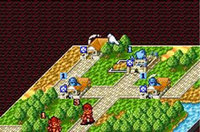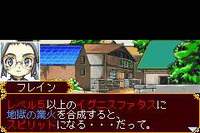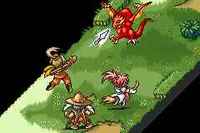|
|

|
PLATFORM
|
GBA
|
BATTLE SYSTEM
|

|
INTERACTION
|

|
ORIGINALITY
|

|
STORY
|

|
MUSIC & SOUND
|

|
VISUALS
|

|
CHALLENGE
|
Unbalanced
|
LANGUAGE BARRIER
|
High
|
COMPLETION TIME
|
40-60 Hours
|
|
OVERALL

|
+ Contains many references to the first game.
+ Unit sprites are all well designed.
+ Mechanics work well in versus mode.
- Story mode is unbalanced.
- Troop casualty rates are Darwinian in scope.
- Quick save fails more often than not.
|
Click here for scoring definitions
|
|
|
The Tales series is broad and wide. Nowadays one would be hard put to find a home console or portable system that lacked one of these games. For all its plethora of titles, the series has almost always held to some version of its linear battle system as a defining characteristic. The following is about one of the rare exceptions.
Tales of the World: Summoner's Lineage breaks the mold in several ways. First is the title; despite the TotW moniker, Lineage is actually a sequel to Tales of Phantasia and brings back many of the characters and locales of that game. Second, and much more extreme, is the shift in genre. Lineage is like no other Tales title as it completely abandons the series' trademark combat in favor of a turn-based strategy format. The developers apparently were aiming for a mix of Fire Emblem, Shining Force, and Famicom Wars in style, but generally failed at the execution.
The twenty-six story battle maps include locations from all corners of the Phantasia game world, but they all share a few basics. One of these is the summoning circle. This structure can exist by itself or be incorporated into fortresses, temples, and ruins. When the protagonist unit is standing on one, the player can summon forth a wide variety of allied units for varying mana costs. Mana is gained each turn and is based on the number of properties (circles, houses, castles, etc.) currently claimed by the player's side. Newly summoned units for either side start at level one, but units can be held over from previous battles with all levels intact. Plot characters carry over automatically between battles.
While this is not too bad a way to set up a game, in actuality each story battle is intentionally stacked against the player. Enemy forces generally control all but one or two of a map's properties from the very beginning, and high-level enemy units come preset in every case. Very rarely will the player start a battle with more than just the protagonist on the map, and often the mana cost of leveled allies will be more than the player can afford for the first round or two. The scholarly protagonist has to be trained up early and quickly to be a magical juggernaut so that he can effectively beat down monsters and gain nearby properties single-handedly if need be.
 All your houses belong to us.
All your houses belong to us.
|
|
The number of high-level enemies on a map is thankfully finite, but the enemy leader can still flood the map with first level summoned forces. While this is a good time to try and work on one's own troops, it's quickly apparent that not all troops are created equal. There are over two hundred unit types in the game, divided into nineteen clades (six of which are human). Some types can be recruited in battle if the player has a suitable pact ring to match the unit's clade or element, but others can only be gained through promotion. Units can be promoted if they meet various criteria, with the requirements often hinted at in the individual unit profiles. The player can also find hints throughout the game to help figure things out. The problem is that generic units rarely survive long enough to be promoted. Lineage's complicated system of clade and elemental advantages makes it difficult at times to know how two units will fare against each other, and a poor guess usually results in death and a waste of mana. Even character allies, who are thankfully exempt from permanent demise, are difficult to train up properly. As strategy titles go, it is positively Darwinian.
Battles are fully automated. As soon as two unit groups engage, the game goes to a battle screen, displays current hit points, and then everyone gets a turn to whack each other. Most of these steps require a confirmation via button press before continuing, so the player cannot step out for a drink and come back to see the results of the enemy's turn just like that. Some units have special skills, either intrinsically or by promotion, that will occasionally kick in during battle. Statistically, enemy units seem to trigger these far more often. The position of a unit within a group determines the turn order for that group, but unfortunately this doesn't seem to have any effect on the defense of the individual units.
Even if one completely abandons strategy and just directs a band of high-level survivors straight at the enemy commander, finishing a map can take a while. Larger maps can take two or three hours to complete, which is a bit much for a portable title. There is a quick save function, but this is a cold comfort as it tends to fail fairly often (about sixty percent of the time, in my experience). Between the huge maps, intentional resets, losses, and involuntary resets because of quick save failure, the player can expect to put in over fifty hours on a game that only has thirty-three maps (counting all the unlockable bonus missions).
 Despite all appearances, I'm pretty sure this bit occurs inside a cave.
Despite all appearances, I'm pretty sure this bit occurs inside a cave.
|
|
The story shows more promise at the beginning. The protagonist is Fulein K. Lester, descendant of the famed summoner Claus F. Lester from Tales of Phantasia. He's on a journey to continue his acclaimed ancestor's work in the study of pact rings and summoning, and at the start of the game he successfully recovers an artifact from the ruins of the world's ancient super-civilization — a fairy-shaped android named Macaron. Around the same time, a newly created android named Xex is learning about life with the help of the kindly magitech researcher who made him. The king has heard about him, however, and sends troops under the assumption that all magitech research is intended to provide weapons for revolution. One attempted arrest results in a dead researcher and a seriously pissed off android. This is one of the few scenes concerning Xex's rise to power as an evil overlord bent on destroying humanity, and to be honest it would have helped if more time were spent on developing him and his monster allies. The same can be said of Fulein's allies: the orphan twins, the swordswoman in search of truth, the hellhound hoping to reform his brother, and the witch seeking vengeance for her lost husband. The good guys get more screen time and development than the baddies, but all around the plot is not as well done as it could have been.
The addition of the Phantasia cast, while obviously intended as a crowd-pleaser, does little to help. Their presence only makes sense because the setting already allows for time travel. Also, unlike the rest of the cast, the Phantasia Six are set in stone personality-wise. Claus is still stoicly odd, and Suzu is emotionally removed. Chester and Arche still snipe at each other while Cress and Mint just need to get a hotel room and be done with it. None of them gain any character development in spite of taking up a goodly portion of the plot.
 Beware the ninja.
Beware the ninja.
|
|
One of the few areas without complaint is the game's spritework, which succeeds in both variety and overall quality. Every type of unit, as well as each of the major characters, possesses a unique sprite in battle. The same things cannot be said of the environmental graphics, however, as the same backgrounds and battlefields are constantly recycled regardless of the big picture. As an example, a battle on a sandy space will always have cacti and a cattle skeleton in it, whether the battle is in a town, a cave, or actually in a desert. Much more could have been done to emphasize the wide variety of the combat maps.
Summoner's Lineage is a title that works much better in its versus mode than in its story mode, which suggests that it may have originally been intended that way. For whatever the reason, it was adapted to fit the needs of its story, but without any thought as to the overall balance that would be needed for such an endeavor. Its story, while interesting, is largely underdeveloped, and that quick save bug should never have made it into the final product. While the game was playable, it felt like something developed by people who understood the concept of strategy titles without a real understanding of how to make them. It certainly isn't up to the standards set by Tales of Phantasia, or even those of its sibling titles, the Narikiri games. It was interesting to see Tales material in such a different format for once, but I can see why Namco never tried it again.
Review Archives
|









